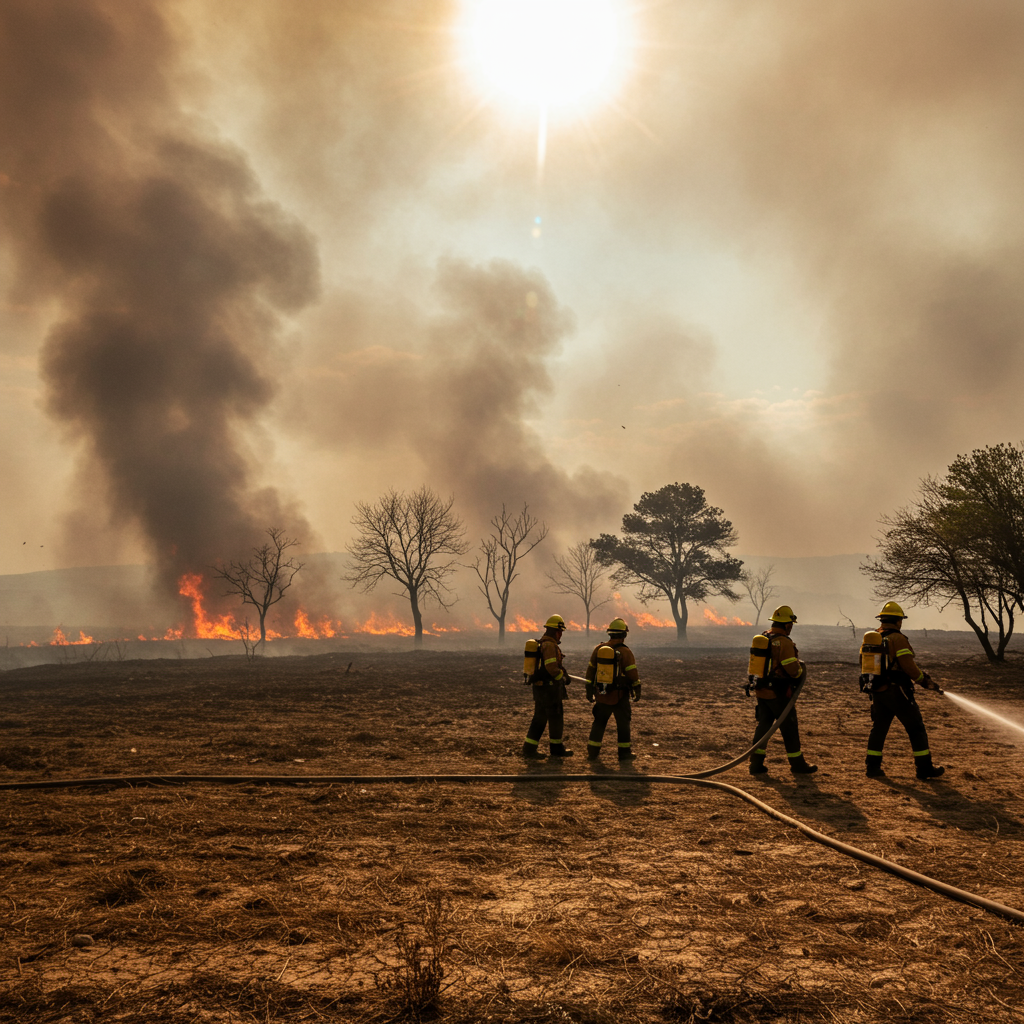Intense wildfires are gripping Greece and turkey, forcing immediate evacuations and triggering large-scale emergency operations as a major European heatwave continues to bake the region. Firefighters are battling relentless blazes fueled by extreme temperatures, strong winds, and arid conditions. These events unfold as Europe experiences temperatures soaring above 40°C in many areas, with experts increasingly linking such extreme weather patterns to climate change.
Wildfires Rage Across Aegean Nations
Greece and Turkey, popular tourist destinations, are facing severe challenges from concurrent wildfire outbreaks. The situation is dynamic, with emergency crews working around the clock to contain fires spreading rapidly through dry scrubland and forests. Authorities in both countries have issued urgent warnings and initiated evacuation protocols in threatened areas, prioritizing human safety above all else. This crisis highlights the vulnerability of the Mediterranean region to the intensifying impacts of climate change during the summer months.
Battling Flames in Greece: Attica and Beyond
A significant new wildfire erupted near the town of Agios Dimitrios in Koropi, eastern Attica, Greece, on Friday afternoon. This blaze quickly prompted emergency evacuations in nearby coastal settlements, including Agios Dimitrios, Galazia Akti, and Althea. Utilizing the 112 emergency alert system, residents received urgent instructions to move towards Lagonissi for safety.
A substantial force was deployed to combat the Koropi fire. Reports indicate 75 firefighters, including five elite ground teams, were on the scene. They were supported by 25 fire engines, a contingent of volunteers, four helicopters, and two firefighting aircraft. Municipal water trucks also assisted in the crucial effort to supply water to ground crews and dampen the spread. This incident follows other recent wildfire activity in Greece, including a major coastal fire on the island of Crete earlier in the week, which led to the evacuation of over 5,000 people, including numerous tourists and hotel staff. Additionally, a separate fire ignited near Marathon, northeast of Athens, earlier in the week, requiring a significant response involving ground crews, helicopters, and another 112 alert for evacuations, demonstrating a challenging fire season across the country.
Turkey Faces Deadly Blazes and Evacuations
In neighboring Turkey, firefighters remain locked in fierce battles to control wildfires, particularly in the western Aegean province of İzmir. Fires had erupted in at least five locations across the province. One major blaze near the town of Ödemiş had been burning for three days by Friday, proving particularly challenging.
Tragically, the fires in Turkey have resulted in at least two fatalities. An 81-year-old man reportedly died from smoke inhalation, while a dedicated forestry worker lost their life while attempting to suppress the flames. The fires have caused extensive damage, destroying or severely impacting approximately 200 homes. As a result, tens of thousands of people have been forced to evacuate their properties and seek safety away from the spreading infernos.
While many fires in Turkey are now reported to be under control following periods of extreme heat, the situation remains critical in affected areas. The fire near Foça, also in the İzmir region, caused significant disruption, prompting the evacuation of around 550 residents from 175 homes and leading to the temporary closure of İzmir Adnan Menderes Airport, leaving hundreds of passengers stranded. The immense effort to control the İzmir fires involved hundreds of personnel, numerous vehicles, and aerial support, with four firefighters reportedly suffering smoke poisoning.
Pinpointing the Causes and Context
Turkish authorities have begun investigating the specific triggers for these devastating fires. Initial reports suggest that many of the blazes in İzmir were caused by faults within power lines. Separately, the fire that broke out near the district of Buca was attributed by officials to sparks generated by construction workers using a grinder to cut metal.
These localized triggers occur within a broader environmental context that creates ripe conditions for wildfire ignition and rapid spread. The current intense heatwave gripping Europe is a primary factor. Record temperatures have been recorded across southern Europe, with Spain seeing up to 46°C and Portugal reaching a staggering 46.6°C – its highest temperature ever recorded for June. This extreme heat leads to parched landscapes, turning vegetation into tinder. Strong winds, often unpredictable, then act as a catalyst, fanning flames and pushing fires across vast distances at alarming speeds. Low humidity levels further exacerbate the dryness of the environment, making it easier for fires to start and harder to extinguish them.
Climate Change Connection: A Growing Threat
Experts and climate scientists are unequivocal: while wildfires are a natural occurrence in the Mediterranean region during summer, climate change is significantly worsening their intensity, frequency, and duration. Europe has warmed at twice the global average rate since the 1980s, making it the fastest-warming continent on Earth, according to a 2024 report by the EU’s Copernicus Climate Change Service. This accelerated warming translates directly into longer, hotter, and drier periods, creating ideal conditions for large, uncontrollable blazes.
The ongoing heatwave itself is seen by many as a stark illustration of the effects of a changing climate. Such extreme heat events are projected to become more common and severe in the coming years. This poses increasing challenges for emergency services and places greater risk on populations living in or near susceptible wildland areas. The link between rising global temperatures and the escalating wildfire threat is a critical concern for policymakers and residents alike. The strain on resources, the impact on air quality, and the long-term ecological and economic costs are significant consequences of this trend.
Addressing the Crisis and Looking Ahead
The immediate priority remains the protection of lives and properties. Emergency services are stretched thin but continue to deploy every available resource – from ground crews and fire engines to helicopters and water-bombing aircraft – to fight the fires. Evacuation orders are a crucial tool to ensure people are moved away from danger zones swiftly.
Beyond the immediate crisis, these events underscore the urgent need for proactive measures. This includes improving forest management practices, implementing stricter regulations on activities that could spark fires during high-risk periods, and investing in better early detection systems and firefighting capabilities. Furthermore, addressing the root cause – climate change – through global efforts to reduce greenhouse gas emissions is paramount to mitigating the long-term risk of increasingly devastating wildfire seasons in regions like Greece and Turkey. The resilience of communities and the effectiveness of preparedness strategies will be severely tested as temperatures continue to rise globally.
Frequently Asked Questions
Where are wildfires currently burning in Greece and Turkey?
As of Friday, July 4, 2025, significant wildfires were actively being battled in several areas. In Greece, a major fire erupted in Koropi, eastern Attica, prompting evacuations. Other recent fires had occurred on the island of Crete and near Marathon in Greece. In Turkey, intense fires were ongoing in the western province of İzmir, particularly near towns like Ödemiş and Buca, while others like the fire near Çeşme were reported as contained.
What is the impact of the recent wildfires in Turkey and Greece?
The wildfires have had severe consequences. In Turkey, they resulted in at least two deaths, damaged around 200 homes, and forced the evacuation of tens of thousands of people. Travel was disrupted, including a temporary airport closure. In Greece, fires have led to widespread evacuations in affected areas, including thousands on Crete and coastal areas near Athens, placing significant strain on emergency services and posing a risk to properties and natural landscapes.
How is the European heatwave connected to these wildfires?
A major, ongoing heatwave across Europe, featuring temperatures exceeding 40°C in southern regions, is creating ideal conditions for wildfires. Extreme heat dries out vegetation, turning it into highly flammable fuel. Combined with strong winds and low humidity, these conditions make it easy for fires to ignite and spread rapidly and intensely. Experts confirm that while summer fires are common, climate change is exacerbating heatwaves, making wildfires more frequent and severe.




